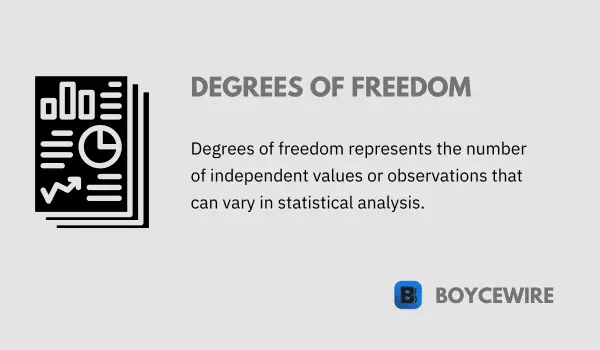Degrees of Freedom: Definition, How to Calculate & Examples

What is Degrees of Freedom?
Degrees of freedom is a fundamental concept in the realm of statistics, offering crucial insights in various fields such as physics, engineering, and machine learning. It represents the number of independent values or parameters that can vary in an analysis without breaching any given constraints. While it might initially seem like a perplexing concept, understanding degrees of freedom is vital for executing statistical tests correctly, interpreting their results, and ensuring the validity of those results.
Key Points
- Degrees of freedom represent the number of observations or data points that are free to vary in statistical analysis.
- In general, it is determined by the sample size minus the number of parameters being estimated.
- Degrees of freedom play a crucial role in hypothesis testing and determining the appropriate statistical distribution for inference.
Understanding Degrees of Freedom
Degrees of freedom (DoF) is a slightly abstract statistical concept that refers to the number of values in a statistical calculation that are free to vary. Simply put, it provides an idea of how much information you have at your disposal to estimate statistical parameters.
Let’s consider a simple example to illustrate this concept: you have a dataset containing five data points, and you know their average (mean). If you know the values of four of these data points, you can easily calculate the value of the fifth data point because it’s constrained by the average. In this case, you have four DoF because four values can freely vary.
This concept becomes increasingly important as we delve into more complex statistical tests and models. For instance, in a chi-square test, DoF are used to define the shape of the chi-square distribution, which in turn helps us determine the critical value for the test. Similarly, in regression analysis, DoF help quantify the amount of information “used” by the model, thus playing a pivotal role in determining the statistical significance of predictor variables and the overall model fit.
Understanding the concept of DoF and accurately calculating it is critical in hypothesis testing and statistical modeling. It not only affects the outcome of the statistical tests but also the reliability of the inferences drawn from such tests.
Different Statistical Tests and Degrees of Freedom
The concept of degrees of freedom (DoF) applies to a variety of statistical tests. Each test uses DoF in its unique way, often defining the shape of the corresponding probability distribution. Here are several commonly used statistical tests and how they use DoF:
- T-tests In a T-test, degrees of freedom determine the specific shape of the T distribution, which varies based on the sample size. For a single sample or paired T-test, the DoF are typically the sample size minus one (n-1). For a two-sample T-test, DoF are calculated using a slightly more complex formula involving the sample sizes and variances of both groups.
- Chi-Square tests For Chi-square tests, used often in categorical data analysis, the DoF are typically the number of categories minus one. In a contingency table, DoF are (number of rows – 1) * (number of columns – 1).
- ANOVA (Analysis of Variance) In an ANOVA, DoF are split between the number of groups minus one (between-group df) and the total sample size minus the number of groups (within-group DoF). The F distribution, used in ANOVA, is determined by these two DoF values.
- Regression Analysis In simple linear regression, DoF are the number of observations minus the number of estimated parameters (usually 2: the slope and intercept). In multiple regression, it’s the number of observations minus the number of parameters estimated (including each predictor and the intercept).
Understanding how degrees of freedom interact with these statistical tests is crucial to selecting the correct test and interpreting its results accurately.
How to Calculate Degrees of Freedom
The exact way to calculate degrees of freedom can vary depending on the specific statistical test being used. However, here are general guidelines for calculating degrees of freedom in some common scenarios:
- Single-Sample t-test The degrees of freedom for a single-sample t-test are calculated as the sample size (n) minus 1. This is because one parameter (the sample mean) is being estimated.
- Paired t-test The degrees of freedom for a paired t-test are calculated as the number of pairs (n) minus 1.
- Two-sample t-test The degrees of freedom for a two-sample t-test can be approximated as the smaller of the two sample sizes (n1 and n2) minus 1.
- Chi-square test For a chi-square test, the degrees of freedom are equal to the number of categories minus 1.
- One-way ANOVA In a one-way ANOVA, the total degrees of freedom is n-1 (where n is the total number of observations). This is split into two parts: the degrees of freedom between groups (k-1 where k is the number of groups) and the degrees of freedom within groups (n-k).
- Regression Analysis In regression analysis, the degrees of freedom are typically calculated as the total number of observations minus the number of parameters being estimated.
Remember that these are general rules, and the exact calculation can sometimes be more complex, particularly for more advanced statistical techniques. Always make sure you understand the statistical method you’re using and the appropriate way to calculate degrees of freedom.
Overfitting and Degrees of Freedom
Overfitting is a critical concept in statistics and machine learning. It refers to a model that fits the data too closely, to the point where it captures not only the underlying patterns but also the random noise in the data. Such a model performs well on the training data but poorly on new, unseen data, thus leading to poor predictive performance and generalization.
The degrees of freedom (DoF) in a statistical model are closely related to the risk of overfitting. A model with too many DoF is likely to overfit the data. This is because having more DoF allows the model to use complex or flexible functions to fit the data, which might capture random noise along with the actual pattern.
For instance, in a regression analysis, increasing the number of predictors increases the DoF, as each additional predictor allows the model to fit the data more closely. While this might seem beneficial, it can lead to overfitting if the model becomes too complex and starts fitting the noise in the data.
On the other hand, reducing the DoF can help prevent overfitting by making the model simpler. Techniques like regularization, which add a penalty term to the loss function based on the number of parameters, effectively reduce the DoF and thus help prevent overfitting.
However, it’s important to strike the right balance. If you reduce the DoF too much, the model might become too simple to capture the underlying patterns in the data, leading to underfitting. As with many aspects of model building, finding the right balance between bias and variance (or underfitting and overfitting) is key.
Limitations of Degrees of Freedom
While degrees of freedom (DoF) are integral to statistical testing and model development, their usage comes with certain limitations and assumptions that need to be considered.
- Assumptions Many statistical tests that utilize DoF often make assumptions about the data being used, such as normality or homoscedasticity. If these assumptions are violated, the tests may not be valid.
- Complexity Understanding and correctly applying DoF can be complex, particularly for those new to statistics. It requires a clear understanding of the underlying statistical principles.
- Risk of Misinterpretation In some cases, people misinterpret the concept of DoF and apply it incorrectly. For example, adding more variables to a model will increase the DoF, but it doesn’t necessarily improve the model as it may lead to overfitting.
- Applicability DoF are more applicable to parametric tests, which assume underlying statistical distributions. For non-parametric tests, which do not make such assumptions, DoF may not be as relevant.
- Overfitting vs. Underfitting As discussed, while controlling DoF can help prevent overfitting, reducing them too much may lead to oversimplification or underfitting of the model. Striking the right balance is key but can be challenging.
In conclusion, while DoF are a crucial concept in statistics and provide invaluable insights, their application needs to be done thoughtfully, considering the nature of the data and the objectives of the statistical analysis or model.
Examples of Degrees of Freedom
To provide a clearer understanding of the concept of degrees of freedom (DoF), let’s look at a few examples in different contexts.
- T-Test When running a t-test, the DoF are typically calculated as the total sample size minus the number of groups. For example, if we are comparing two groups each with 10 samples, the DoF would be 10+10-2 = 18. This calculation becomes crucial when looking up the t-distribution table to determine the critical t-value.
- Chi-Square Test In a chi-square test for independence, the DoF are calculated as (number of rows – 1) * (number of columns – 1). For instance, if we’re analyzing a contingency table with 3 rows and 3 columns, the DoF would be (3-1)*(3-1) = 4.
- ANOVA In an Analysis of Variance (ANOVA), there are two types of DoF – between groups and within groups. If there are ‘n’ groups each of size ‘m’, the DoF between groups would be n-1 and within groups would be n*(m-1).
- Regression Analysis In regression, the DoF is the number of observations minus the number of estimated parameters. So, if we have 100 observations and we are estimating 3 parameters (two coefficients and a constant), then the DoF would be 100 – 3 = 97.
Remember, these are simplistic examples and in real-world applications, the calculations may become more complex, taking into account various factors such as assumptions about the population, the design of the study, and so on.
FAQs
Degrees of freedom refer to the number of independent values or observations that can vary in statistical analysis.
Degrees of freedom are typically calculated as the difference between the total number of observations or data points and the number of parameters or restrictions in the statistical model.
Degrees of freedom determine the appropriate statistical distribution for hypothesis testing and help assess the reliability of statistical estimates.
Increasing the sample size generally increases the degrees of freedom, allowing for more precise and reliable statistical inferences.
About Paul
Paul Boyce is an economics editor with over 10 years experience in the industry. Currently working as a consultant within the financial services sector, Paul is the CEO and chief editor of BoyceWire. He has written publications for FEE, the Mises Institute, and many others.

Further Reading
 Absolute Poverty: Definition, Examples & Causes - Absolute poverty is where an individual is unable to meet their immediate needs.
Absolute Poverty: Definition, Examples & Causes - Absolute poverty is where an individual is unable to meet their immediate needs.  Deregulation: Definition, Pros, Cons & Examples - Deregulation is where governments reduce the level of interference that they have in the marketplace. This involves looking at previous…
Deregulation: Definition, Pros, Cons & Examples - Deregulation is where governments reduce the level of interference that they have in the marketplace. This involves looking at previous…  Horizontal Integration: Definition, Examples, Pros & Cons - When two businesses that are part of the same industry join together to form one company.
Horizontal Integration: Definition, Examples, Pros & Cons - When two businesses that are part of the same industry join together to form one company. 
